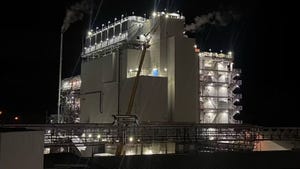Braskem utilizes Brasilplast as a springboard for news, new products
Braskem's outsized 2000-sq-m stand dominated the Anhembi show floor at last week's Brasilplast in São Paulo, but the company believes that its investments in vinyl, bioplastics, and conventional polyolefins will be what keeps the South American plastics and chemical maker at the market's forefront.
May 17, 2011
Braskem's outsized 2000-sq-m stand dominated the Anhembi show floor at last week's Brasilplast in São Paulo, but the company believes that its investments in vinyl, bioplastics, and conventional polyolefins will be what keeps the South American plastics and chemical maker at the market's forefront.
Although the company launched 16 products at the show and detailed its plans for $1 billion polyvinyl chloride (PVC) production site at Marechal Deodoro in the Brazilian state of Alagoas, much of the buzz around the company is still generated by its sugar-cane-ethanol derived Green polyethylene (PE), which began commercial production in September of last year with annual capacity of 200,000 tonnes.
Leonora Novaes, green polymers commercial leader at Braskem, told PlasticsToday that the material is being utilized by Fortune 500 companies like Procter & Gamble, Coca Cola, and Johnson & Johnson in a variety of commercially available products ranging from single-use rigid and flexible packaging to durable goods, including waste containers.
Novaes said that its primary markets are in Europe and Asia, but it has sold sugar-cane based high-density polyethylene (HDPE) and linear low-density polyethylene (LLDPE) into the U.S. as well as locally into the Brazilian market, although most of the material is exported at this time. Novaes said that part of the material's appeal is how it fits into the current polyolefin recycling stream. "Our Green material is polyethylene," Novaes said, "that's the good thing. PE is PE whether it's green or petrochemical."
Andrew Swanson, global relationship manager for Chemical Market Associates Inc. (CMAI; Houston) noted the ascendancy of the South American country in the nascent field of biochemistry in a presentation as part of his company's Latin American Petrochemicals and Polymers Conference. "Brazil has been a leader for renewables," Swanson said. "It has led the way in fuel, and it's leading in materials in many ways."
Part of the advantage has to do with the country's sugar-cane ethanol industry, long developed as the primary source of transportation fuel in the country. Swanson said that when crude oil is priced at $75-$80/bbl, the cost structure favors sugar cane PE. By comparison, for U.S. corn, which is the primary feedstock for bioplastic competitor, polylactic acid, it requires oil of $100-$120/bbl, while for EU wheat to be competitive, oil must be at $140/bbbl.
Braskem also has a project in the works to start marketing a Green polypropylene (PP) in 2013, making the material at a smaller 30,000 tonnes/yr plant and bringing relief to a market that has watched prices creep into the triple digits in 2011. "PP as a tightening olefin," Swanson said. "This is a place where renewables can offer relief."
About the Author(s)
You May Also Like


